AzureWave Technologies CM389NF Marvell 88W8897 802.11ac 2x2Wi-Fi+BT Combo Adapter User Manual
AzureWave Technologies, Inc. Marvell 88W8897 802.11ac 2x2Wi-Fi+BT Combo Adapter Users Manual
Contents
Users Manual
User Guide
© Copyright 2014 Hewlett-Packard
Development Company, L.P.
The information contained herein is subject
to change without notice. The only
warranties for HP products and services are
set forth in the express warranty statements
accompanying such products and services.
Nothing herein should be construed as
constituting an additional warranty. HP shall
not be liable for technical or editorial errors
or omissions contained herein.
First Edition: July 2014
Document Part Number: 784240-001
Product notice
This guide describes features that are
common to most models. Some features
may not be available on your computer.
Software terms
By installing, copying, downloading, or
otherwise using any software product
preinstalled on this computer, you agree to
be bound by the terms of the HP End User
License Agreement (EULA). If you do not
accept these license terms, your sole
remedy is to return the entire unused
product (hardware and software) within 14
days for a refund subject to the refund
policy of your seller.
For any further information or to request a
full refund of the price of the computer,
please contact your seller.

Safety warning notice
WARNING! To reduce the possibility of heat-related injuries or of overheating the computer, do not
place the computer directly on your lap or obstruct the computer air vents. Use the computer only on
a hard, flat surface. Do not allow another hard surface, such as an adjoining optional printer, or a soft
surface, such as pillows or rugs or clothing, to block airflow. Also, do not allow the AC adapter to
come into contact with the skin or a soft surface, such as pillows or rugs or clothing, during operation.
The computer and the AC adapter comply with the user-accessible surface temperature limits defined
by the International Standard for Safety of Information Technology Equipment (IEC 60950).
iii
iv Safety warning notice

Table of contents
1 Starting right ...................................................................................................................................................... 1
Best practices ....................................................................................................................................... 1
Fun things to do .................................................................................................................................... 1
More HP resources .............................................................................................................................. 2
2 Getting to know your device .............................................................................................................................. 3
Identifying components ........................................................................................................................ 3
Labels ................................................................................................................................................... 7
3 Connecting to the Internet on your Chrome device .......................................................................................... 8
Connecting to a wired network (select devices only) ........................................................................... 8
Connecting to a wireless network ......................................................................................................... 9
Connecting to a Bluetooth device or network (select devices only) ..................................................... 9
Connecting to a mobile network (select devices only) ......................................................................... 9
Enabling and disabling Wake on LAN (WOL) function (select devices only) ..................................... 10
4 Using the Chrome desktop ............................................................................................................................. 11
Using the launcher ............................................................................................................................. 11
Using the shelf .................................................................................................................................... 11
Using the status area and settings ..................................................................................................... 11
5 Using apps ...................................................................................................................................................... 12
Managing apps ................................................................................................................................... 12
6 Managing files ................................................................................................................................................. 13
Managing files .................................................................................................................................... 13
Physical file media and transfers ........................................................................................................ 13
7 Using Settings ................................................................................................................................................. 14
Internet connection ............................................................................................................................. 14
Appearance ........................................................................................................................................ 14
Device ................................................................................................................................................ 14
Search ................................................................................................................................................ 15
Users .................................................................................................................................................. 15
Advanced settings .............................................................................................................................. 16
v
8 Using audio and video on your Chrome device .............................................................................................. 18
Using audio ........................................................................................................................................ 18
Connecting speakers ......................................................................................................... 18
Connecting headphones .................................................................................................... 18
Using video ......................................................................................................................................... 18
Connecting an HDMI device .............................................................................................. 19
Connecting a digital display device .................................................................................... 19
Streaming content to a high-definition TV or monitor (select devices only) ....................... 20
Changing screen resolution ................................................................................................................ 20
9 Using TouchPad gestures ............................................................................................................................... 21
Using TouchPad gestures .................................................................................................................. 21
Dragging and dropping ...................................................................................................... 21
Tapping .............................................................................................................................. 21
Scrolling ............................................................................................................................. 23
10 Using the keyboard and mouse .................................................................................................................... 25
Using the action keys ......................................................................................................................... 25
11 Securing your Chrome device and information ............................................................................................. 27
Securing your wireless network .......................................................................................................... 27
Locking and unlocking your device .................................................................................................... 27
Using an optional security cable lock ................................................................................................. 28
12 Backing up and recovering your Chrome device and data ........................................................................... 29
Backing up your software applications and information ..................................................................... 29
Recovering your Chrome device ........................................................................................................ 29
13 Maintenance ................................................................................................................................................. 30
Cleaning your device .......................................................................................................................... 30
Cleaning procedures .......................................................................................................... 30
Cleaning the display .......................................................................................... 30
Cleaning the device vents (select devices only) ............................................... 31
Cleaning the keyboard or mouse (select devices only) ..................................... 31
14 Power and Battery ........................................................................................................................................ 32
Factory-sealed battery ........................................................................................................................ 32
Charging the Battery .......................................................................................................... 32
15 Electrostatic Discharge ................................................................................................................................. 33
vi
16 Accessibility Features ................................................................................................................................... 34
Index ................................................................................................................................................................... 35
vii
viii

1Starting right
Your Chrome device is a powerful tool designed to enhance your work and entertainment. Read this
chapter to learn about best practices after setup, fun things to do with your device, and where to find
additional HP resources.
Best practices
To get the most out of your smart investment, after you set up and register the device, we
recommend the following steps:
●If you haven’t already done so, connect to a wired or wireless network. See details in Connecting
to the Internet on your Chrome device on page 8.
●Become familiar with the device hardware and software. For more information, see Using audio
and video on your Chrome device on page 18.
●Update or purchase antivirus software at the Google Play store.
Fun things to do
●Did you know that you can connect your device to a television? For more information, see
Connecting an HDMI device on page 19.
●Did you know that you can also stream live radio to the device and listen to music or talk radio
from all over the world? See Using audio on page 18.
●Did you know that you can use Google Docs and Google Sheets to get work done on the go,
and that you can save your work to the cloud, from almost anywhere in the world? For more
information on saving files to the cloud, see Managing files on page 13.
Best practices 1

More HP resources
You have already used
Setup Instructions
to turn on the Chrome device and locate this guide. To
locate product details, how-to information, and more, use this table.
Resource Contents
Setup Poster ●Overview of device setup and features.
Help and Support
For U.S. support, go to http://www.hp.com/go/contactHP. For
worldwide support, go to http://welcome.hp.com/country/us/en/
wwcontact_us.html.
●A broad range of how-to information and
troubleshooting tips.
Worldwide support web page
To get support in your language, go to http://welcome.hp.com/
country/us/en/wwcontact_us.html.
●Online chat with an HP technician.
●Email support.
●Find support telephone numbers.
●Locate HP service center locations.
Safety & Comfort Guide
Go to http://www.hp.com/ergo.
●Proper workstation setup.
●Guidelines for posture and work habits that
increase your comfort and decrease your risk
of injury.
●Electrical and mechanical safety information.
Regulatory, Safety and Environmental Notices
This guide is provided in the box.
●Important regulatory notices, including proper
battery disposal information.
Limited Warranty
This guide is provided in the box, or go to http://www.hp.com/go/
orderdocuments.
●Specific warranty information about this device.
2 Chapter 1 Starting right
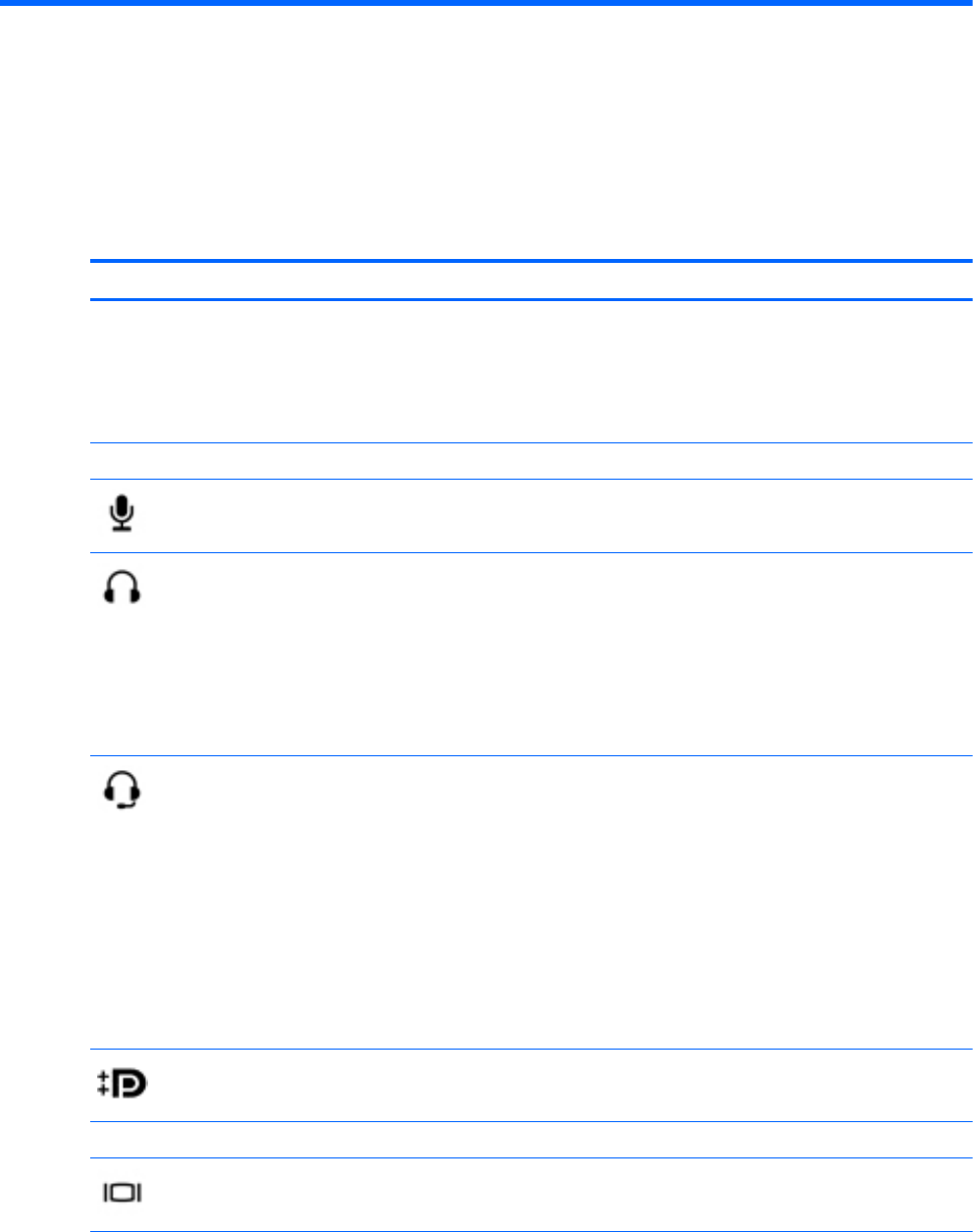
2 Getting to know your device
Identifying components
Your device may support the following components. For more information, refer to the
Setup Poster
,
included in the box.
Component Description
AC adapter light ●White: The AC adapter is connected and the battery is
charged.
●Amber: The AC adapter is connected and the battery
is charging.
●Off: The computer is using battery power.
Action keys Execute frequently used functions.
Audio-in (microphone) jack Connects an optional computer headset microphone,
stereo array microphone, or monaural microphone.
Audio-out (headphone) jack Connects optional powered stereo speakers, headphones,
earbuds, a headset, or a television audio cable.
WARNING! To reduce the risk of personal injury, adjust
the volume before using headphones, earbuds, or a
headset. For additional safety information, see the
Regulatory, Safety and Environmental Notices
.
NOTE: When a device is connected to a headphone jack,
the device speakers are disabled.
Audio-out (headphone)/Audio-in
(microphone) jack
Connects optional powered stereo speakers, headphones,
earbuds, a headset, or a television audio cable. Also
connects an optional headset microphone. This jack does
not support optional microphone-only devices.
WARNING! To reduce the risk of personal injury, adjust
the volume before putting on headphones, earbuds, or a
headset.
NOTE: When a device is connected to the jack, the
device speakers are disabled.
NOTE: Be sure that the device cable has a 4-conductor
connector that supports both audio-out (headphone) and
audio-in (microphone).
DisplayPort Connects an optional digital display device, such as a high-
performance monitor or projector.
esc key Launches the task manager when used with the shift key.
External monitor port Connects an external VGA monitor or projector.
Identifying components 3
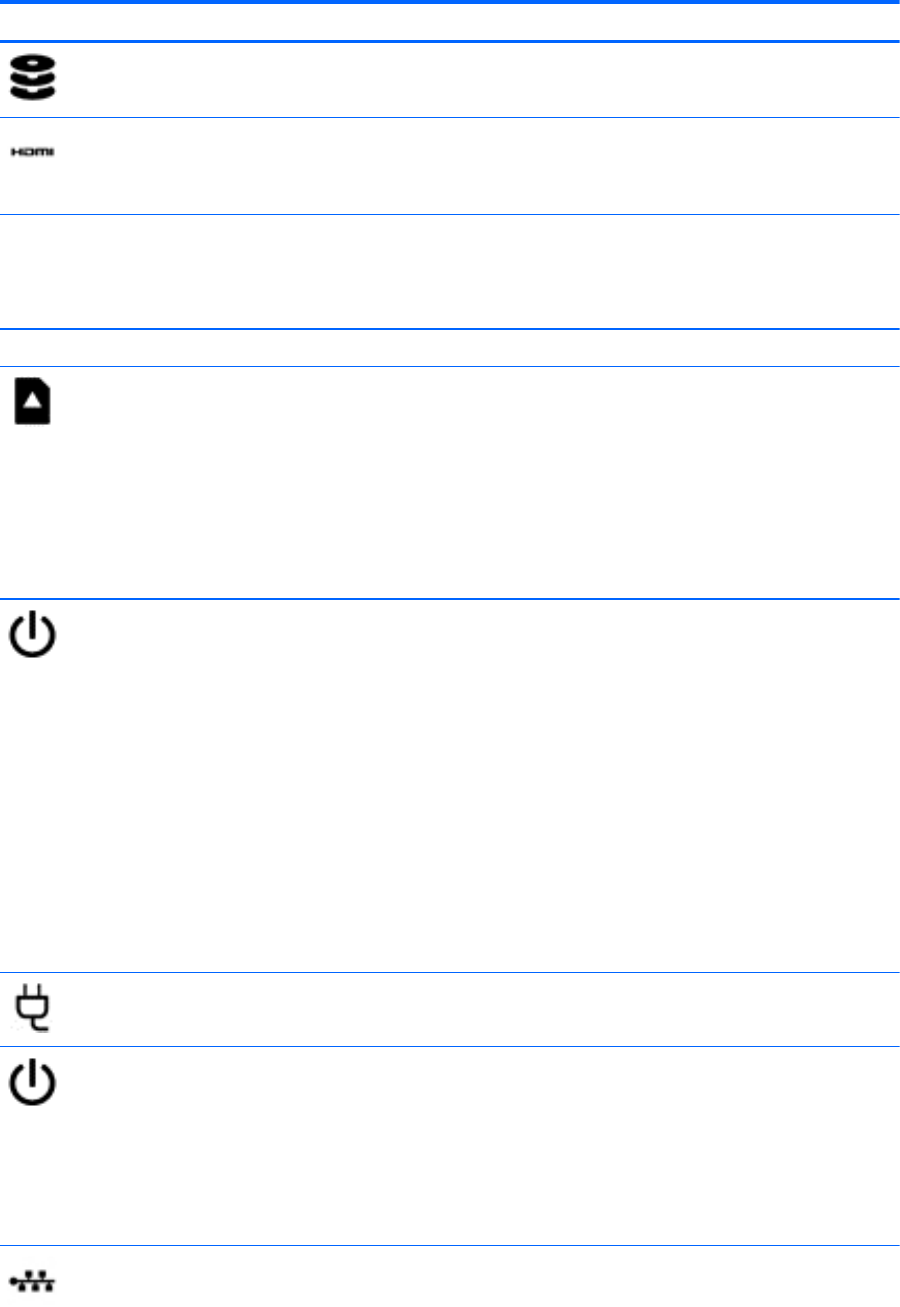
Component Description
Hard drive light ●The hard drive is being accessed.
HDMI port Connects an optional video or audio device, such as a high-
definition television, any compatible digital or audio
component, or a high-speed High-Definition Multimedia
Interface (HDMI) device.
Internal display switch Turns off the display and initiates Sleep if the display is
closed while the power is on.
NOTE: The internal display switch is not visible from the
outside of the computer.
Internal microphones Record sound.
Memory card reader Reads optional memory cards that store, manage, share, or
access information.
To insert a card:
▲Hold the card label-side up, with connectors facing the
slot, insert the card into the slot, and then push in on
the card until it is firmly seated.
To remove a card:
▲Press in on the card it until it pops out.
Power button ●When the device is in the Sleep state, press the button
briefly to exit Sleep.
NOTE: You can also exit Sleep by lifting the display or
pressing any key. Sleep is initiated by the system after a
certain period of inactivity, or when you lower the display.
●When the device is off, press the button to turn on the
device.
●When the device is on and you want to lock the
screen, press the power button until the sign-in screen
appears.
●When the screen is locked, press the power button to
turn the device off.
CAUTION: Pressing and holding down the power button
will result in the loss of unsaved information.
Power connector Connects an AC adapter.
Power light Your device may have more than one power light. Each
may display different light conditions, depending on device
behavior.
●On: The device is on.
●Blinking: The device is in the Sleep state, a power-
saving mode.
●Off: The device is off.
RJ-45 (network) jack/status lights Connects a network cable. The color of the lights may be
different, depending on your device.
4 Chapter 2 Getting to know your device
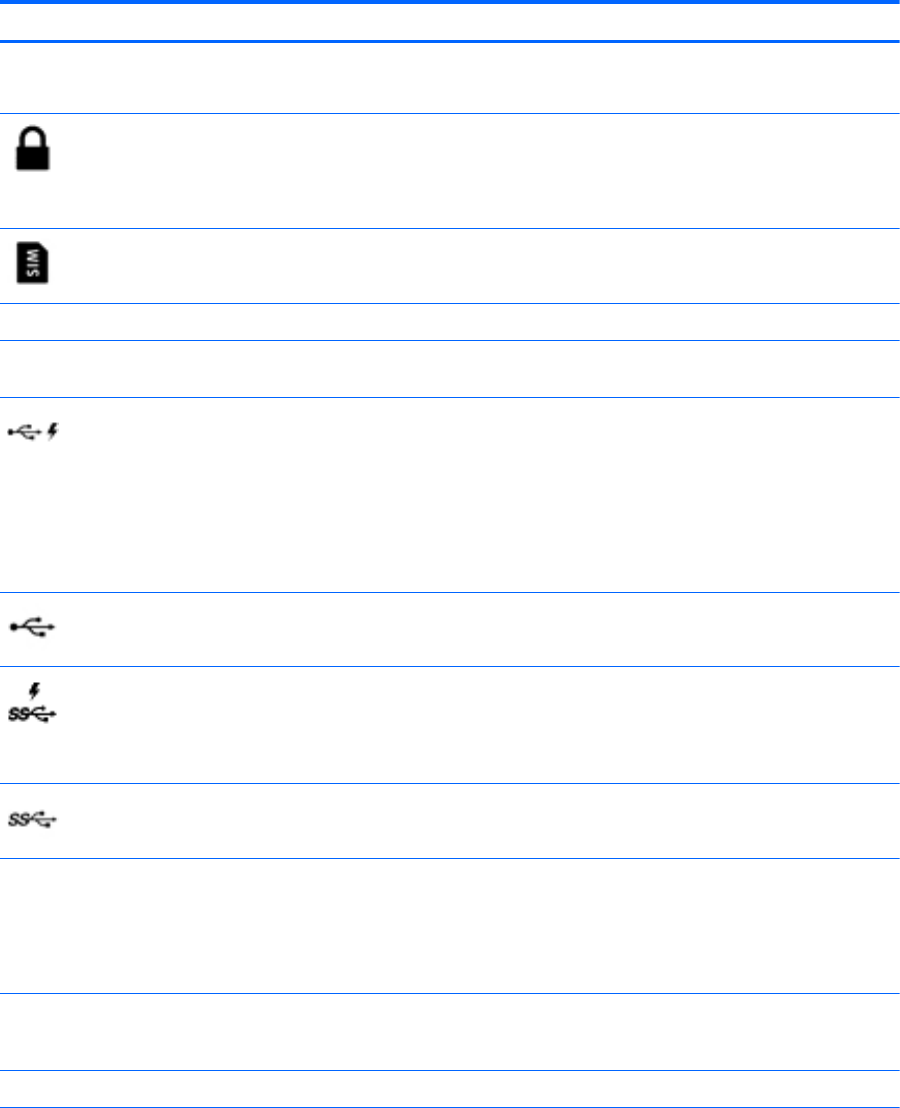
Component Description
●White: The network is connected.
●Amber: Activity is occurring on the network.
Security cable slot Attaches an optional security cable to the device.
NOTE: The security cable is designed to act as a
deterrent, but it may not prevent the device from being
mishandled or stolen.
SIM slot (select models only) Supports a wireless subscriber identity module (SIM).
Speakers Produce sound.
TouchPad zone Reads your finger gestures to move the pointer or activate
items on the screen.
USB 2.0 charging (powered) port Connects an optional USB device, such as a keyboard,
mouse, external drive, printer, scanner or USB hub.
Standard USB ports will not charge all USB devices or will
charge using a low current. Some USB devices require
power and require you to use a powered port.
NOTE: USB charging ports can also charge select models
of cell phones and MP3 players, even when the device is in
Sleep mode.
USB 2.0 port Connects an optional USB device, such as a keyboard,
mouse, external drive, printer, scanner or USB hub.
USB 3.0 charging (powered) port Connects an optional USB device, such as a keyboard,
mouse, external drive, printer, scanner or USB hub.
Standard USB ports will not charge all USB devices or will
charge using a low current. Some USB devices require
power and require you to use a powered port.
USB 3.0 port Connects an optional USB device, such as a keyboard,
mouse, external drive, printer, scanner or USB hub.
Vents Enable airflow to cool internal components.
NOTE: The device fan starts up automatically to cool
internal components and prevent overheating. The number
of vents vary depending on the device. It is normal for the
internal fan to cycle on and off during routine operation.
Webcam Records video and captures photographs. Some devices
allow you to video conference and chat online using
streaming video.
Webcam light On: The webcam is in use.
WLAN antennas Send and receive wireless signals to communicate with
WLANs.
Identifying components 5

Component Description
NOTE: The antennas are not visible from the outside of
the device. For optimal transmission, keep the areas
immediately around the antennas free from obstructions.
For wireless regulatory notices, see the section of the
Regulatory, Safety, and Environmental Notices
that applies
to your country or region.
WWAN antennas Send and receive wireless signals to communicate with
WWANs.
NOTE: The antennas are not visible from the outside of
the device. For optimal transmission, keep the areas
immediately around the antennas free from obstructions.
For wireless regulatory notices, see the section of the
Regulatory, Safety, and Environmental Notices
that applies
to your country or region.
6 Chapter 2 Getting to know your device
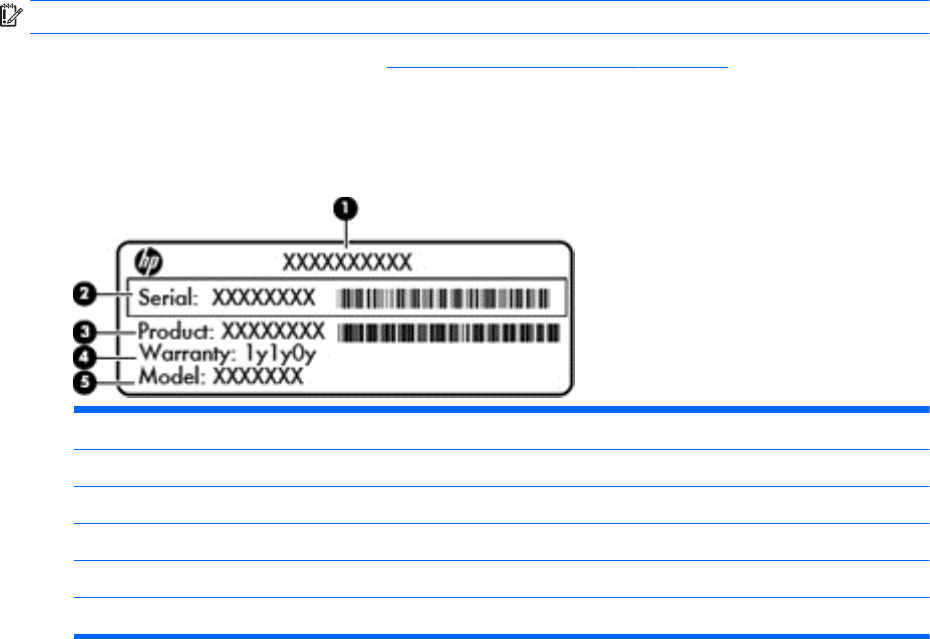
Labels
The labels affixed to the device provide information you may need when you troubleshoot system
problems or travel internationally with the device:
IMPORTANT: All labels described in this section will be affixed to the bottom of the device.
For help finding these locations, refer to Getting to know your device on page 3
●Service labelThe label affixed to the bottom of your device provides important information to
identify the unit. When contacting support, you will probably be asked for the serial number, and
possibly for the product number or the model number. Locate these numbers before you contact
support.
Component
(1) Product name
(2) Serial number (s/n)
(3) Part number/Product number (p/n)
(4) Warranty period
(5) Model description (select models only)
●Regulatory label(s)Provide(s) regulatory information about the device.
●Wireless certification label(s)Provide(s) information about optional wireless devices and the
approval markings of some of the countries or regions in which the devices have been approved
for use.
Labels 7
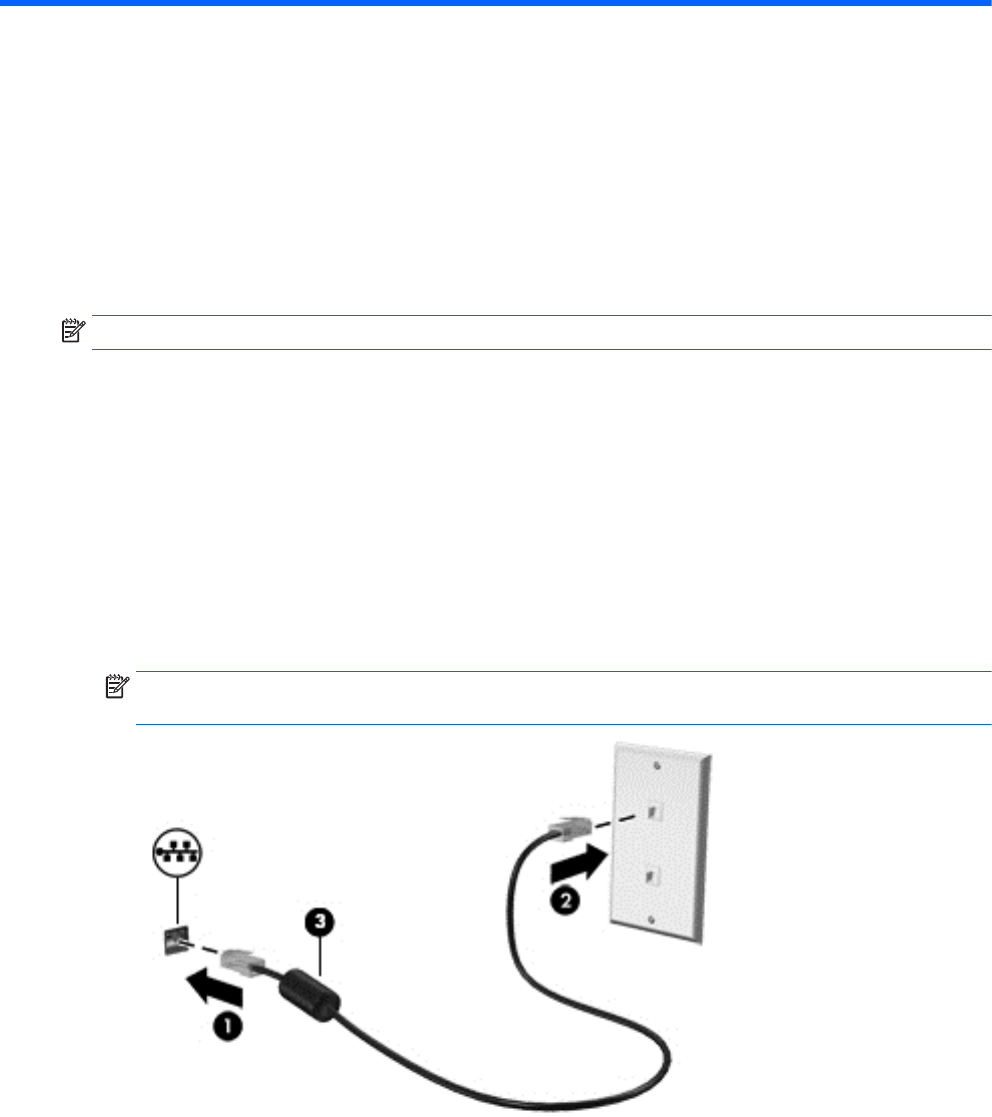
3 Connecting to the Internet on your
Chrome device
Connecting to the internet is quick and easy on your Chrome device. Follow the directions in the
sections below to connect to a wired local area network (LAN) or to connect wirelessly through your
device’s WLAN antennas or by Bluetooth (select models only). For more information about the
location of your antennas, and a quick-start guide, see the
Setup Poster
included with your device.
NOTE: The icons on the Chrome desktop and the appearance of the screen may vary.
Connecting to a wired network (select devices only)
Use a LAN connection if you want to connect the device directly to a router in your home (instead of
working wirelessly), or if you want to connect to an existing network at your office.
Connecting to a LAN requires an 8-pin, RJ-45 (network) cable, or an optional micro-SD cable with a
network adapter connected to it.
To connect to a wired network:
1. Plug the network cable into the network jack (1) on the device.
2. Plug the other end of the network cable into a network wall jack (2) or router.
NOTE: If the network cable contains noise suppression circuitry (3), which prevents
interference from TV and radio reception, orient the circuitry end of the cable toward the device.
8 Chapter 3 Connecting to the Internet on your Chrome device
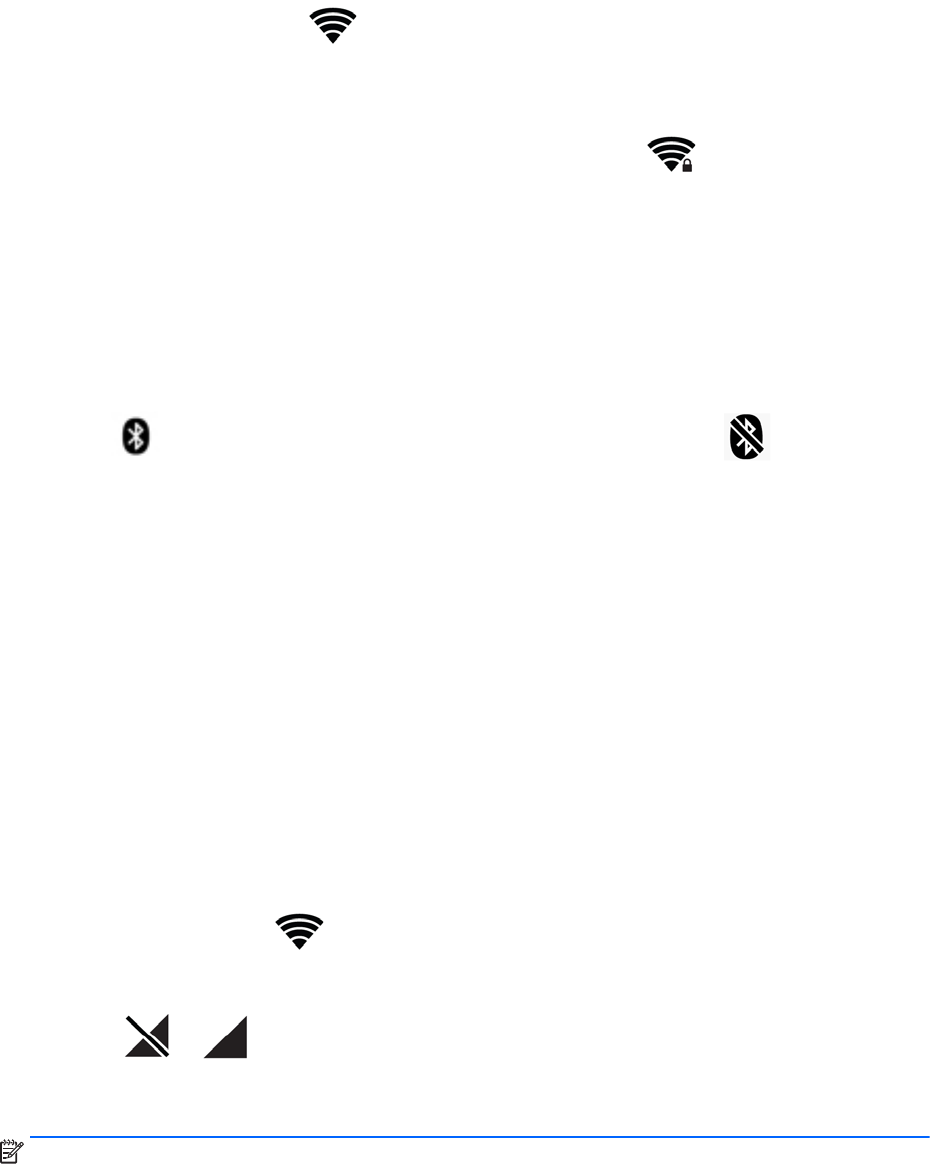
Connecting to a wireless network
To connect to a wireless network, follow the steps below.
1. From the Chrome desktop, click the Chrome menu and then select Wireless networks available,
or select the wireless icon in the status area at the lower right side of the screen.
2. Select the wireless network you want to access and click Connect.
3. Provide passwords and encryption keys as prompted. A network protected with a password
and/or encryption key is indicated by the secure connection icon . Contact your network
administrator for more information, if needed.
Connecting to a Bluetooth device or network (select devices
only)
Pair a compatible Bluetooth product, such as a headset, keyboard, or mouse with your device by
following the steps below.
1. Click the status area in the lower-right corner of the desktop to display the status menu. If you
see Bluetooth enabled, Bluetooth is currently connected. If you see Bluetooth
disabled in the menu, Bluetooth is currently disconnected.
2. If Bluetooth is disabled, you can select Bluetooth disabled > Enable Bluetooth in the menu. Your
Chrome device scans for available Bluetooth devices.
3. Select the device you want to add and click Connect.
4. Follow the instructions on the screen to connect your Bluetooth device. Some devices create a
PIN needed to complete the process.
Connecting to a mobile network (select devices only)
To connect to a network controlled by a mobile provider (for example, a data service plan through a
cellular provider), a SIM module must be installed on your Chrome device, and you must have
activated your mobile network account with your provider.
If a SIM module is not preinstalled, you can purchase it separately. To insert the SIM module, see the
manufacturer’s documentation for your module. After the module is installed, follow the steps below to
connect to a mobile network.
1. Click the network icon in the lower-right corner of your screen.
2. Click your network status on the menu that appears.
3. Click or on the menu that appears. If you don't see these options, that means your
Chrome device is not able to use mobile networks.
4. To connect, select your mobile network's name from the network menu.
NOTE: You may be asked to enter a personal identification number (PIN) if the SIM module is
locked.
Connecting to a wireless network 9

NOTE: Your Chrome device will use the mobile network to transmit data only when no other
networks are connected. To ensure that your device transmits data over the mobile network, disable
Wi-Fi from the network menu. For more information, see Using Settings on page 14.
Enabling and disabling Wake on LAN (WOL) function (select
devices only)
Wake on LAN (WOL) is a function that allows your device to be turned on by a message sent across
your local area network, or LAN.
NOTE: Wake on LAN only functions when a LAN cable is attached. WOL resets to its default setting
(WOL-enabled) after a system reboot.
NOTE: Accessing the WOL function requires initiating a Recovery and entering developer mode.
Ensure that all of your files are saved to the cloud or to an external drive before proceeding.
The process for enabling and disabling WOL may change as the operating system is updated. For
further information and updates, go to http://www.hp.com/support, and select your country. Select
Drivers & Downloads, and then follow the on-screen instructions to find documentation relevant to
your device. You may also refer to http://www.chromium.org/chromium-os/developer-information-for-
chrome-os-devices for information about accessing developer mode.
You may turn this function on and off by following the directions below:
1. Altering WOL settings requires entering development mode. Please refer to
http://www.chromium.org/chromium-os/developer-information-for-chrome-os-devices for
directions on accessing developer mode on your device.
2. After initiating developer mode, the system restarts automatically and prompts you to set up your
language and keyboard again before logging on to your user account.
3. After logging in, from the Chrome desktop, press Ctrl + Alt + F2 or Ctrl + Alt + → to enter console
mode.
4. On the console screen, type root and press Enter.
5. At the next prompt, type ethtool -s eth0 wol d and press Enter to disable WOL function. To
enable WOL function, type ethtool s eth0 wol g and press Enter.
6. Press Ctrl + Alt + F1 or Ctrl + Alt + → to return to the Chrome desktop.
NOTE: Changes to Wake on LAN functions may only be applied when a LAN cable is attached.
WOL will be reset to its default setting (WOL-enabled) after a system reboot.
10 Chapter 3 Connecting to the Internet on your Chrome device
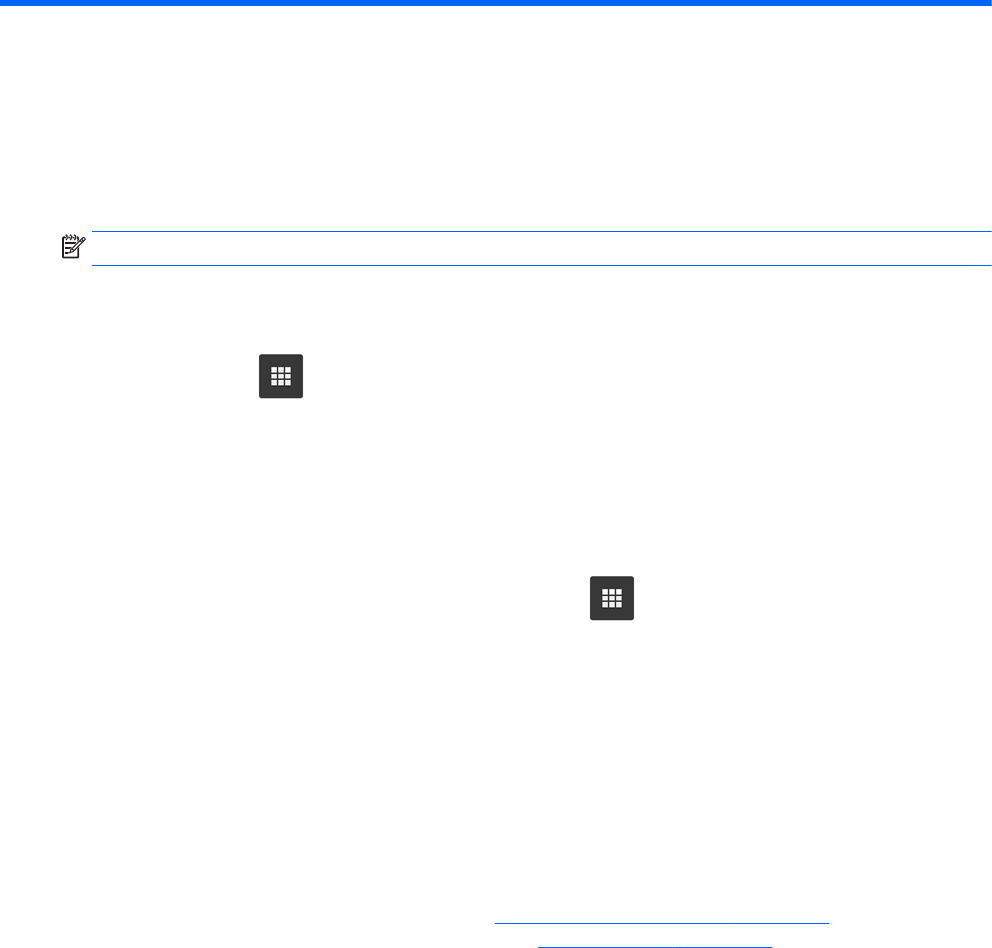
4 Using the Chrome desktop
The desktop provides a central location where you can customize the information, media, and
applications you want to access quickly. You may click or touch any icon below to perform the action
described.
NOTE: The icons on the desktop and the appearance of the desktop may vary depending on model.
Using the launcher
The launcher icon at the lower left side of the screen allows access to a list of all the available
apps on your Chrome device.
Using the shelf
The shelf along the lower edge of the screen contains popular shortcuts to apps so that you can find
them easily. You can customize this list of apps at any time by pinning and unpinning apps there.
To pin an app to the shelf, click or tap the launcher icon , select an app, right-click or two-finger
tap the app, and then select Pin to shelf.
To unpin an app, right-click or two-finger tap it, and select Unpin.
Using the status area and settings
The status area at the lower right side of the Chrome desktop provides information about your
network status, power status, and which account you’re currently using. Click or tap the status area,
and a menu appears. Select Settings to access to the Settings page. Here, you can change how
input devices like the mouse, TouchPad, external keyboards, and displays work, and regulate web
browsing and device permissions.
To learn more about the Settings page, go to https://support.google.com/chromeos/ and search for
information about this topic. You may also refer to Using Settings on page 14 in this guide.
Using the launcher 11

5 Using apps
Chrome is a lightweight but powerful operating system that gives you access to thousands of free and
paid apps to let you work and play wherever you go.
Managing apps
You can expand the productivity and entertainment capabilities of your Chrome device with free or
purchased apps that can be downloaded directly to your device.
To find and install apps, visit the Chrome webstore at https://chrome.google.com/webstore/user/
purchases#user/purchases. Using the store requires a Google account, but the store maintains a list
of every app you have ever installed, even if you’ve uninstalled them. This way, you’ll never lose an
app due to reformatting the operating system. Apps update automatically, ensuring that you always
have the most recent version installed.
To open an app you’ve installed:
▲Click the launcher icon and select the app from the list, or select the icon for the app you
want from the apps pinned to the shelf at the bottom of the main screen.
To pin or unpin an app to the shelf on the main screen:
▲Click the launcher icon , and select the app. Right-click or two-finger tap the app, and then
select Pin to shelf. To unpin an app, right-click or two-finger tap it and select Unpin.
To uninstall an app:
▲Click the launcher icon , and select the app. Right-click or two-finger tap the app, and then
select Remove from Chrome.
To learn more about managing apps, go to https://support.google.com/chromeos/ and search for
information about the topic.
12 Chapter 5 Using apps

6 Managing files
You can manage files on your hard drive or where they’re stored on the cloud through the Files app,
and you can access your files on other devices, either through cloud storage or by transferring the
files to a data storage device such as a USB flash drive.
Managing files
Programs like Google Docs and Google Sheets help you to stay productive wherever you are in the
world, and you can download audio and video files to your Chrome device. The Files app helps keep
your information organized. To use the Files app, follow the steps below.
1. From the Chrome desktop, click the launcher icon.
2. From the apps list, select the Files app icon.
3. From the left menu In the Files app, select the file collection you want to open.
4. Double-click the file to open it, or, if using a touch screen device, double-tap it.
You can access Google Drive, from this app, and you can download your files stored on the cloud to
whichever device you’re logged onto at any time. So you can always access your files, even if you’re
using a device that doesn’t use Chrome.
Can’t find the file you’re looking for? Use the search box in the upper left corner of the app to search
by keywords in your file’s name or contents.
To learn more about file management, go to https://support.google.com/chromeos/, and search for
information about this topic.
Physical file media and transfers
Your device may have USB, microSD, or other ports for storage media. Backing up your important
files on physical media like USB flash drives or memory cards can help protect you from data loss if
your device must be reset to its factory state. You may also use a USB flash drive, USB hard drive, or
memory card to transfer your files from your Chrome device to another device.
Managing files 13

7 Using Settings
You can adjust the settings for your mouse and TouchPad, web browsing, and device permissions
from the Settings page.
To open the settings page, click in the status area on the lower right side of the desktop. Then select
Settings.
On the Settings page, there are five major subsections, as well as a link to Advanced settings. These
subsections are Internet connection, Appearance, Device, Search, and Users.
Internet connection
In this area, you can add connections, set proxies, and enable and disable wireless and mobile
connections. To learn more about managing networks in Chrome, go to https://support.google.com/
chromeos/ and search for information about the topic.
Appearance
In this area, you can adjust your wallpaper, get themes, and adjust other cosmetic details of your
Chrome experience.
Device
The following sections describe how to adjust the way in which your Chrome device functions.
Touchpad and mouse speed
This area allows you to control the responsiveness of the mouse and TouchPad controls.
To adjust TouchPad or mouse speed, move the slider to the right to increase the speed with which
the arrow moves on the screen in response to device input. Move the slider to the left to decrease the
speed with which the arrow responds to input.
Clicking the Touchpad settings button opens the Touchpad window, in which you can adjust tap-to-
click settings and scrolling preferences.
Keyboard settings
Clicking the Keyboard settings button opens the Keyboard settings window. Here you can set which
key opens the Search function, and how the Ctrl and Alt keys function.
Additionally, you can set the action keys to work as function keys, which may be required by some
websites or applications. To make this change, start by opening the Settings page. Click in the status
area at the lower right side of the desktop. Then select Settings. On the Settings page, find the
Device subsection, and select Keyboard settings. In the Keyboard settings window, select Treat top-
row keys as function keys.
You can also change your keyboard’s language and input settings from this window. To learn more
about keyboard language settings, go to https://support.google.com/chromeos/ and search for more
information about the topic.
14 Chapter 7 Using Settings

Display settings
Clicking this button opens the Manage Displays window, which allows you to change the resolution,
orientation, and other elements of your display. Here, you can select from available screen
resolutions, change the orientation of the screen from landscape to portrait, and adjust mirroring to
other display devices.
Search
In this subsection of the Settings page, you can adjust which search engine you want to use while
browsing the web. To do so, select from the list of search engines provided. To learn more about
managing your search engines or using a search engine not in the list provided, go to
https://support.google.com/chromeos/ and search for more information about the topic.
Users
In this area, you can adjust who can use your Chrome device, and how. For instance, you can enable
a security setting to require a user to enter a password to exit Sleep, so that other people cannot gain
access to your account just because they have your device.
Select Require a password to wake from sleep to ensure that if your device initiates Sleep while it is
unattended, no one can access your account or information without your password.
Advanced sync settings
Under Advanced sync settings, you can determine which elements of your Chrome experience and
preferences will be saved to your Google account. Apps, Autofill, Bookmarks, Extensions, History,
Passwords, Settings, Themes, and Open Tabs are synched to your Google account by default. To
change this, select Choose what to sync and clear the check boxes for the items that you do not want
to be saved for use when you log on to your Google account from a different access point.
Under Encryption options, you can change the security settings for your Google account. By default,
Google encrypts all synced passwords with your Google credentials. For added security, you can
encrypt all your synced data with a passphrase.
For more details, go to https://support.google.com/chromeos/ and search for more information about
the topic.
Manage other users
Select Enable Guest browsing to determine if people need to log on to a Google account before using
the device. By default, guest browsing is enabled, which allows a guest to use the device to browse
the internet, and nothing more.
Select Show usernames and photos on the sign-in screen. By default, this feature is enabled and
shows a list of people who have accessed their accounts on this device.
Select Restrict sign-in to the following users to specify access to your device. By default, this feature
is disabled, but enabling it allows you to type in a list of Google account users who are allowed to
access your device. Only those on the list may use the device to sign in.
For more details, go to https://support.google.com/chromeos/, and search for information about these
topics.
Search 15

Advanced settings
Clicking on Show advanced settings reveals a hidden subsection of the Settings page, where you can
adjust the date and time, alter privacy settings, adjust accessibility options, and much more.
CAUTION: Changing many of these settings can compromise the security of your device, and is not
recommended. For more details, go to https://support.google.com/chromeos/, and search for
information about these topics.
NOTE: The settings available in this area may differ, depending on model and operating system
updates.
Date and time
Under Date and time, you can select your time zone and switch to a twenty-four hour clock, if you
want to do so.
Privacy
Under Privacy, you can control how your internet browsing functions. You can select whether or not
to enable malware and phishing protection, set up voice searches, and enable predictive searches in
your web browser.
Clicking the Content settings button opens the Content settings window. Here, you can enable or
disable cookies, determine if all images on web pages will be shown, enable JavaScripts, block pop-
up windows, and set which input devices are used for web communication, such as your microphone
and webcam. For more details, go to https://support.google.com/chromeos/, and search for
information about these topics.
Clicking the Clear browsing data button opens the Clear browsing data window. Here, you can clear
your internet history cache, cookies, and any passwords you may have saved.
Bluetooth
Under Bluetooth, you can enable or disable your device’s interaction with Bluetooth devices.
Passwords and forms
Under Passwords and forms, you can manage your web passwords and Autofill settings. Autofill is a
service that remembers addresses and credit card numbers that you have entered into websites in
the past. Removing these pieces of personal information before giving your Chrome device to
someone else is a good idea.
Web content
Under Web content, you can customize the font size, and page zoom of web pages that you visit, for
better readability.
Languages
Under Languages, you can customize your keyboard type and shift to an international keyboard by
clicking the Language and input settings button.
Downloads
Under Downloads, you can set a custom location for downloaded files to be sent, and enable or
disable access to Google Drive, Google’s cloud file storage service.
16 Chapter 7 Using Settings

HTTP/SSL
Under HTTP/SSL, you can manage web certificates from sites that recognize your device and
accounts. For more details, go to https://support.google.com/chromeos/, and search for information
about these topics.
Google Cloud Print
Under Google Cloud Print, you can manage your access to printers that are ready for use with
Google’s Cloud Print service, and select which available printer you want to use. For more details, go
to https://support.google.com/chromeos/, and search for information about this topic.
On startup
Under On startup, you can adjust how your device behaves when it first turns on. You can select from
starting on a New Tab page, continuing where you last left off, or from a specific page or set of pages.
Accessibility
Under Accessibility, you can adjust elements of your Chrome device to make it easier to use. You can
enable large fonts and a larger mouse cursor, set the device to use a high contrast mode for better
visibility, turn on sticky keys, enable the on-screen keyboard, or turn on ChromeVox, which provides
audio feedback. For more details, go to https://support.google.com/chromeos/, and search for
information about these topics.
Powerwash
Under Powerwash, you can remove all user accounts on this device and reset it to its factory
condition.
CAUTION: HP recommends backing up all personal files before resetting your device. Your Google
account information and files on cloud services like Google Drive will be unaffected by a powerwash,
but files stored locally will be deleted if you do not back them up.
For more details, go to https://support.google.com/chromeos/, and search for information about this
topic. You may also refer to Backing up and recovering your Chrome device and data on page 29.
Reset browser settings
Under Reset browser settings, you can restore your web browser’s settings to their original defaults.
Advanced settings 17

8 Using audio and video on your Chrome
device
Use your Chrome device as an entertainment hub to enjoy and manage your music, and download
and watch movies. Or, to make your device an even more powerful entertainment center, connect
external devices like a monitor, projector, TV, speakers, and headphones.
NOTE: Your device may not support all of these types of audio and video components. Refer to the
Setup Poster
, included in the box, for more detailed information.
Using audio
On your Chrome device, you can download and listen to music, stream audio content from the web
(including radio), record audio, or mix audio and video to create multimedia. To enhance your
listening enjoyment, attach external audio devices such as speakers or headphones.
Connecting speakers
You can attach wired speakers to your device by connecting them to a USB port or to the audio-out
(headphone) jack on your device.
To connect
wireless
speakers to your device, follow the device manufacturer's instructions. To
connect high-definition speakers to the device, see Connecting an HDMI device on page 19. Before
connecting speakers, lower the volume setting.
Connecting headphones
You can connect wired headphones to the headphone jack on your device.
To connect
wireless
headphones to your device, follow the device manufacturer's instructions.
WARNING! To reduce the risk of personal injury, lower the volume setting before putting on
headphones, earbuds, or a headset. For additional safety information, see the
Regulatory, Safety and
Environmental Notices
.
Using video
Your Chrome device is a powerful video device that enables you to watch streaming video from your
favorite websites and download video and movies to watch later without needing to connect to a
network.
To get the most out of your device, use one of the video ports on the device to connect an external
monitor, projector, or TV. Your device may have a high-definition multimedia interface (HDMI) port,
which allows you to connect a high-definition monitor or TV, or a DisplayPort interface, for connecting
to a DisplayPort-compatible device.
IMPORTANT: Be sure that the external device is connected to the correct port on the Chrome
device, using the correct cable. Check the device manufacturer's instructions.
18 Chapter 8 Using audio and video on your Chrome device
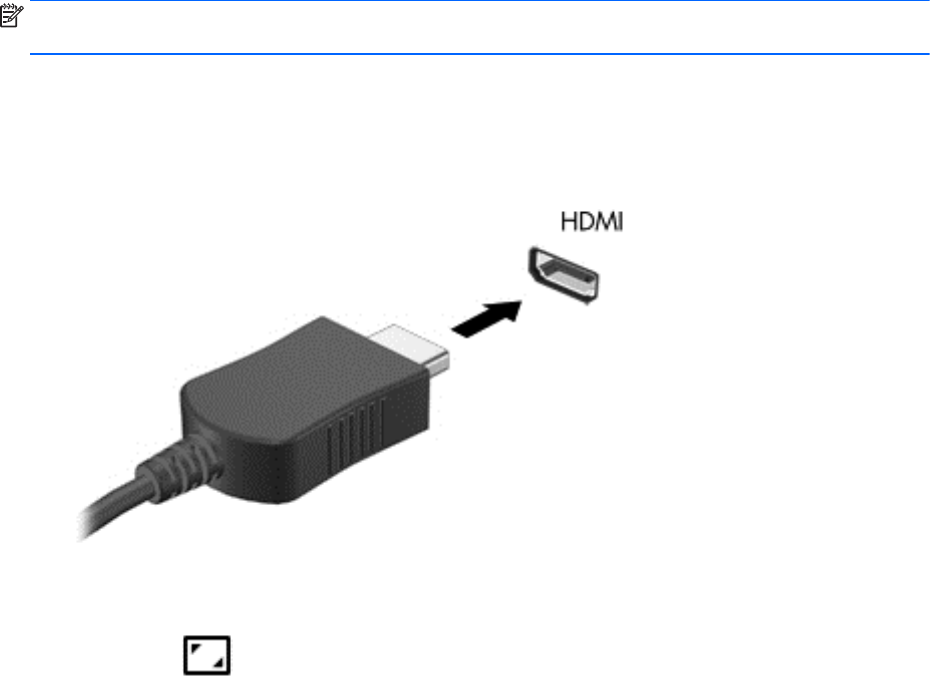
Connecting an HDMI device
NOTE: To connect an HDMI device to your Chrome device, you need an HDMI cable, sold
separately.
To see the device screen image on a high-definition TV or monitor, connect the high-definition device
according to the following instructions:
1. Connect one end of the HDMI cable to the HDMI port on the device.
2. Connect the other end of the cable to the high-definition TV or monitor.
3. The Chrome desktop now appears on your display device. If it does not display automatically,
press Ctrl + to mirror your screen to the display device.
Connecting a digital display device
The DisplayPort connects a digital display device such as a high-performance monitor or projector.
The DisplayPort delivers higher performance than a VGA external monitor port and improves digital
connectivity.
1. Connect one end of the DisplayPort cable to the DisplayPort on the Chrome device.
Using video 19
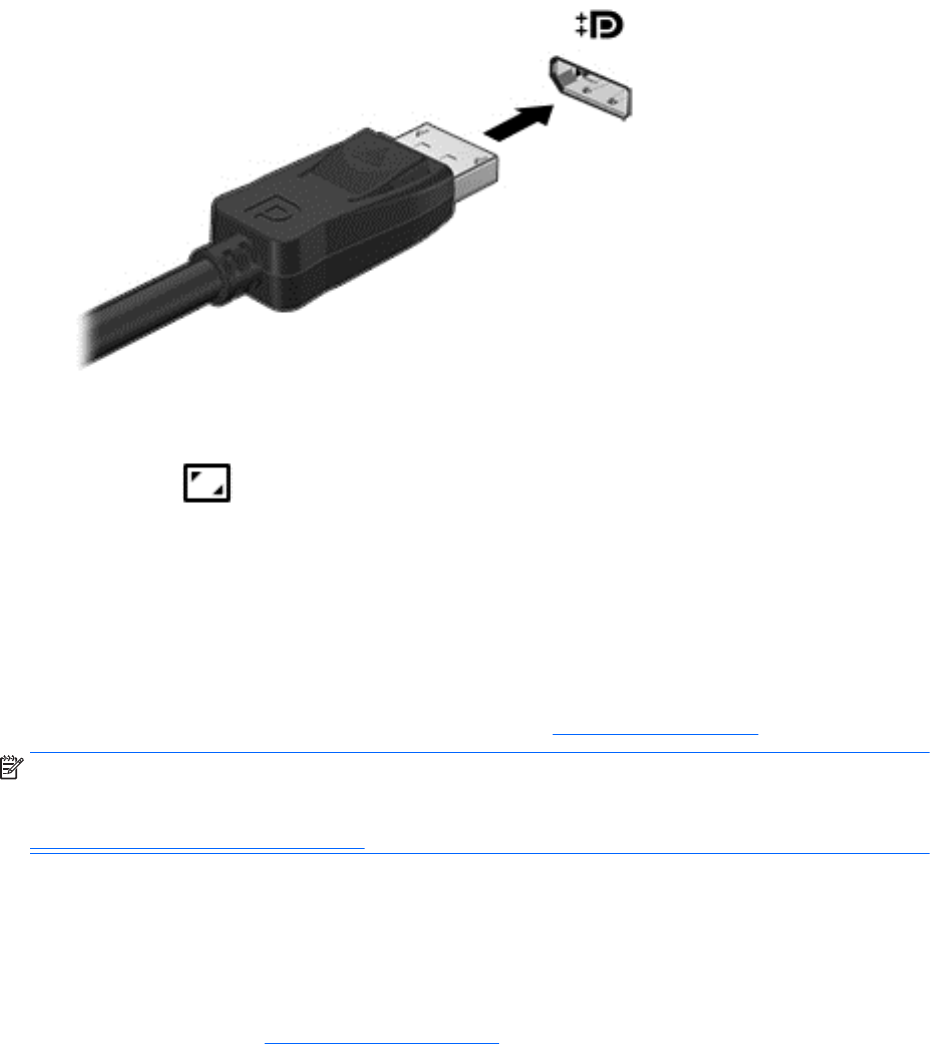
2. Connect the other end of the cable to the digital display device.
3. The Chrome desktop now appears on your display device. If it does not display automatically,
press Ctrl + to mirror your screen to the display device.
Streaming content to a high-definition TV or monitor (select devices only)
Cast screen
technology allows you to stream or display content, such as a movie, wirelessly from
your device to a compatible display device, such as a high-definition TV or monitor. If the content has
already been downloaded to your device, you can access it through the file manager.
If your content is available through a service, such as Amazon Instant Video, Hulu, Netflix, or Google
Play, or other applicable service, you must download an app in order to access your content and view
it, either on your device or on a high-definition screen. See Using apps on page 12 for more details.
NOTE: Chrome does not currently support wirelessly streaming data to a monitor or TV. You may
use an optional external wireless adapter and an affiliated app, such as a Chromecast, to do so. To
learn more about setting up a Chromecast device with your Chrome device, go to
https://support.google.com/chromeos/.
Changing screen resolution
To change the screen resolution, click the status area in the lower-right corner of your desktop. Select
Settings, and go to the Device subsection. Click the Display settings button, and adjust your screen
resolution on the Display settings page.
For more information, see Using Settings on page 14.
20 Chapter 8 Using audio and video on your Chrome device
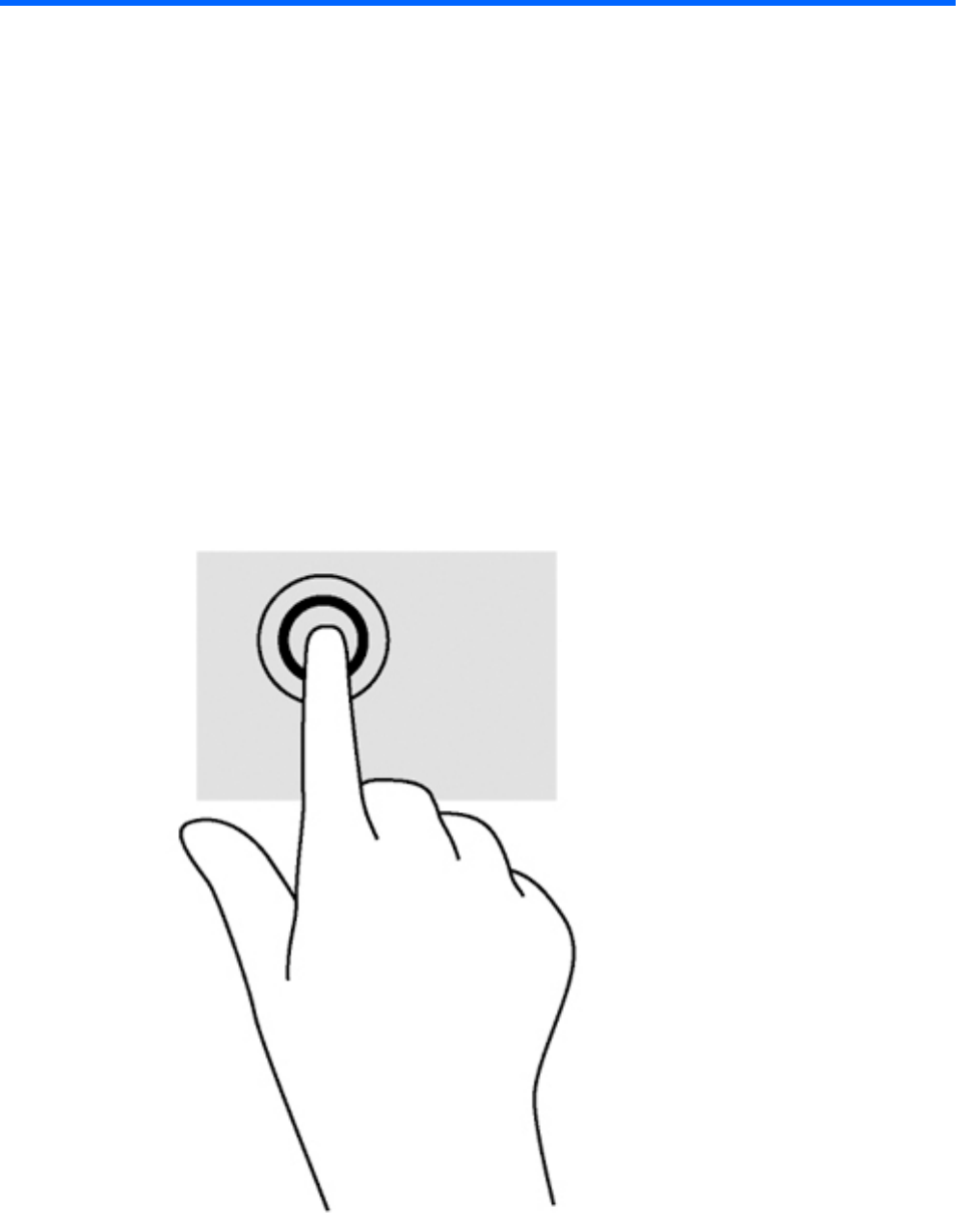
9 Using TouchPad gestures
A TouchPad allows you to control the pointer on the screen using your fingers.
Using TouchPad gestures
The TouchPad supports a variety of gestures that let your fingers tap and scroll to manipulate items
on the desktop
Dragging and dropping
Select the item you want to move with one finger. Move the item with two fingers. When you have
positioned the item where you want it, remove both fingers from the TouchPad to drop the item at its
new location.
Tapping
To make an on-screen selection, use the Tap function on the TouchPad.
●Tap one finger on the TouchPad zone to make a selection.
Using TouchPad gestures 21
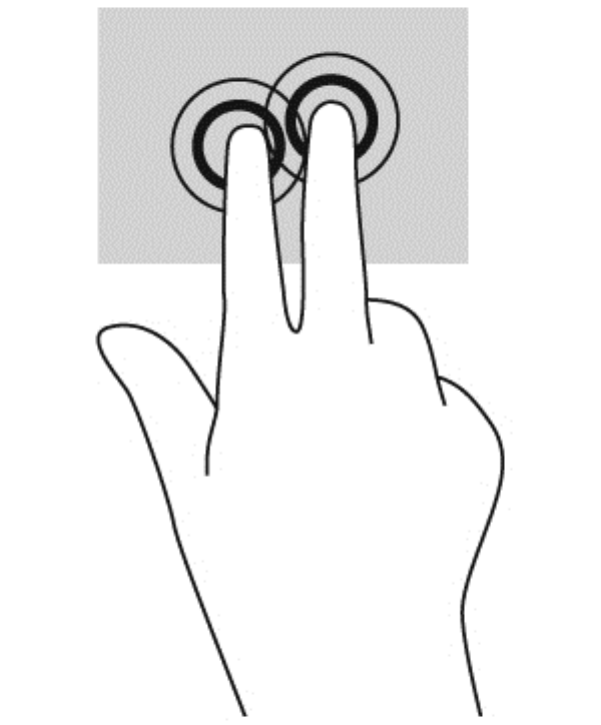
●Tap two fingers on the TouchPad zone to bring up a context-sensitive menu.
22 Chapter 9 Using TouchPad gestures
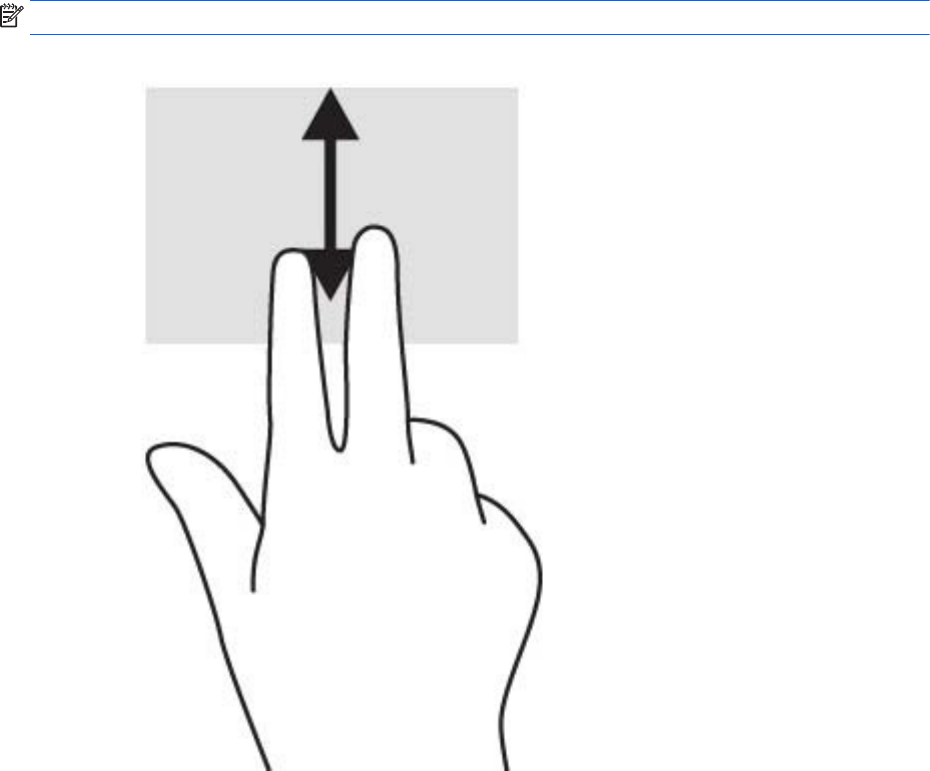
Scrolling
Scrolling is useful for moving up, down, or sideways on a page or image. Scrolling to the left or the
right with two fingers will scroll the screen, if there is more content viewable to either side, or will
move back and forth through web browser history.
To scroll, place two fingers slightly apart on the TouchPad, and then drag them across the TouchPad
in an up, down, left, or right motion.
NOTE: Scrolling speed is controlled by finger speed.
Using TouchPad gestures 23
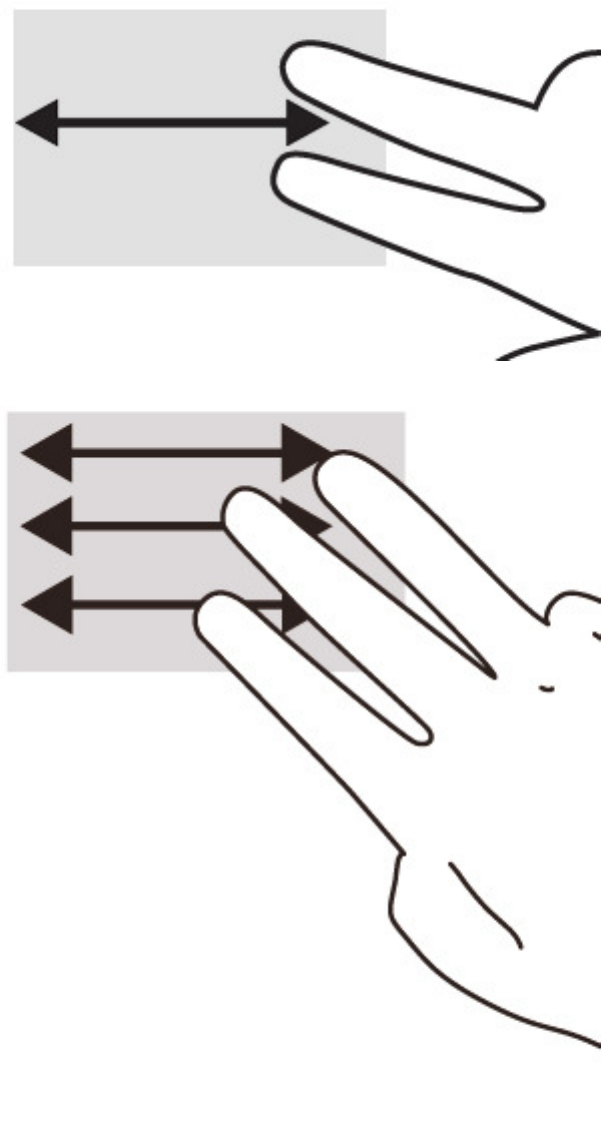
To scroll between open tabs in Chrome, slide three fingers left or right on the TouchPad.
24 Chapter 9 Using TouchPad gestures
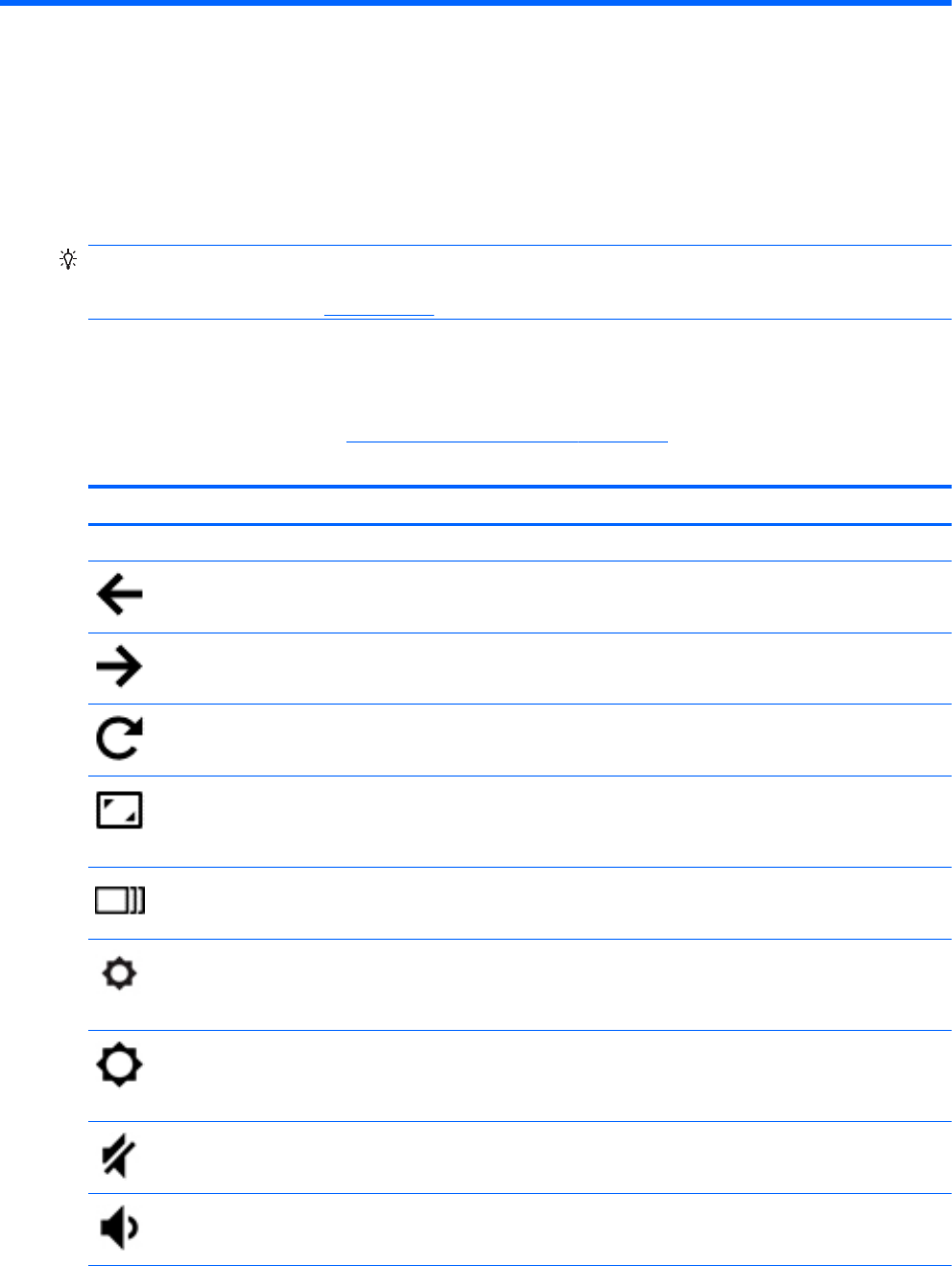
10 Using the keyboard and mouse
Chrome devices may have either integrated keyboards, or may require connecting an optional,
Chrome-compatible external keyboard and mouse to allow you to type, select items, scroll and to
perform other functions. Chrome-compatible keyboards also allow you to use action keys to perform
specific functions.
TIP: HP recommends using a Chrome-compatible keyboard with your device. External keyboards
not compatible with Chrome may not offer the same action key functionality. To find a Chrome-
compatible keyboard, go to www.hp.com.
Using the action keys
Not every Chrome device or external keyboard has the same action keys. To learn more about the
keyboard and shortcuts, go to https://support.google.com/chromeos/ and search for information on
the topics.
Icon Key Description
esc esc is a key that interacts with other keys to activate the device’s functions.
Back Go to the previous page in your browser history.
Forward Go to the next page in your browser history.
Reload Reload your current page.
Full screen Open your page in full-screen mode.
NOTE: Pressing this button in conjunction with ctrl lets you mirror your screen to an
external display.
Display
apps
Displays open apps.
NOTE: Pressing this button in conjunction with ctrl takes a screenshot.
Brightness
down
Decreases the screen brightness incrementally as long as you hold down the key.
NOTE: If your external display does not support DDC/CI, then the brightness key
may not function.
Brightness
up
Increases the screen brightness incrementally as long as you hold down the key.
NOTE: If your external display does not support DDC/CI, then the brightness key
may not function.
Mute Mutes speaker sound.
Volume
down
Decreases speaker volume incrementally as long as you hold down the key.
Using the action keys 25
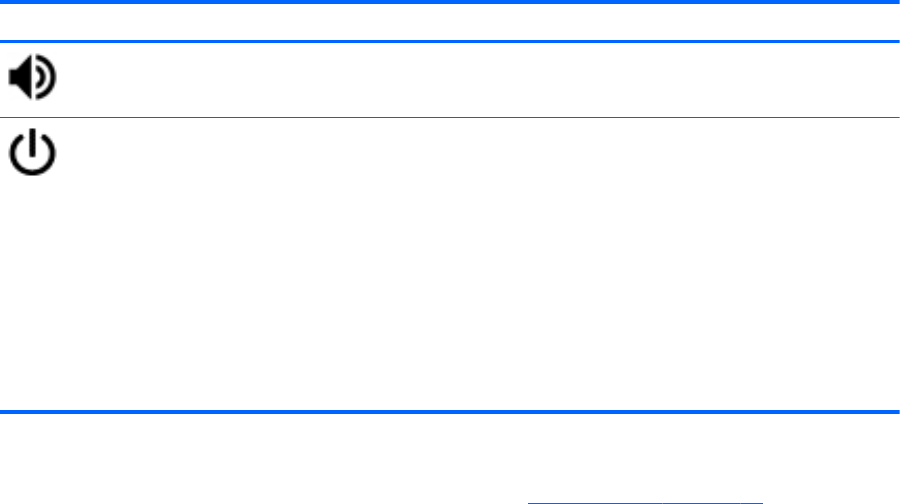
Icon Key Description
Volume up Increases speaker volume incrementally as long as you hold down the key, and
restores sound from mute.
Power
button
●When the device is in the Sleep state, press the button briefly to exit Sleep.
NOTE: You can also exit Sleep by lifting the display or pressing any key. Sleep is
initiated by the system after a certain period of inactivity, or when you lower the
display.
●When the device is off, press the button to turn on the device.
●When the device is on and you want to lock the screen, press the power button
until the sign-in screen appears.
●When the screen is locked, press the power button to turn the device off.
CAUTION: Pressing and holding down the power button will result in the loss of
unsaved information.
You can also set the action keys to work like conventional function keys, which may be required for
some websites and applications. For more information, see Using Settings on page 14.
26 Chapter 10 Using the keyboard and mouse

11 Securing your Chrome device and
information
Device security is essential for protecting the confidentiality, integrity, and availability of your
information. Standard security solutions and third-party software can help protect your device from a
variety of risks, such as viruses, worms, and other types of malicious code.
When you log on to Chrome and enable sync, Chrome keeps your information secure by using your
Google Account credentials to encrypt your synced passwords. Alternatively, you can choose to
encrypt all of your synced data with a sync passphrase. This sync passphrase is stored on your
device, and isn't sent to Google. To learn more, go to https://support.google.com/chromeos/ and
search for information about the topic.
IMPORTANT: Some security features listed in this chapter may not be available on your device.
Device risk Security feature
Unauthorized use of the device Sign-in password
Viruses Antivirus, phishing, and malware protection
Ongoing or future threats to the device Software updates
Unauthorized removal of the device Security cable lock
Securing your wireless network
When you set up your wireless network, always enable security features.
Locking and unlocking your device
Whenever you leave your Chrome device unattended, it’s a good idea to lock the screen, at a
minimum. You may also set a password to protect your screen lock.
To lock the screen, click the lock icon in the status area or press the power button briefly. The log
in screen appears. To set a screen password for added security, follow the steps below.
1. Log on to your Chrome device.
2. Click the status area in the lower-right corner.
3. Select Settings and find the Users section.
4. Select the Require password to wake up from sleep check box, and set your password there.
You may also set your device so that only authorized users may log on to their accounts on it. For
more information, see Using Settings on page 14. To learn more about security passwords and
locking your screen, go to https://support.google.com/chromeos and search for more information
about the topic.
Securing your wireless network 27
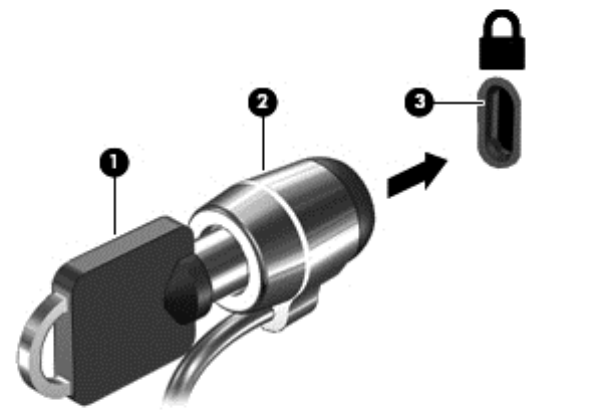
Using an optional security cable lock
A security cable lock, which is purchased separately, is designed to act as a deterrent, but it may not
prevent the device from being mishandled or stolen. Security cable locks are only one of several
methods that should be employed as part of a complete security solution to help maximize theft
protection.
The security cable slot on your Chrome device may look slightly different from the illustration in this
section.
1. Loop the security cable lock around a secured object.
2. Insert the key (1) into the security cable lock (2).
3. Insert the security cable lock into the security cable slot on the device (3), and then lock the
security cable lock with the key.
4. Remove the key and keep it in a safe place.
28 Chapter 11 Securing your Chrome device and information

12 Backing up and recovering your Chrome
device and data
Backing up your software applications and information
All apps update automatically, and a record of your downloads and purchases is kept in the Chrome
Store. Google also saves your last synched settings automatically. If you have to perform a recovery
on your device, you can login with your Google account and automatically retrieve all of your settings,
favorites, and apps.
Saving important documents and files either to a USB stick, memory card, external hard drive, or to
Google Cloud storage is recommended. You may save your files to the cloud at any time by selecting
the Google Drive as your file save location.
Recovering your Chrome device
If you want to give your Chrome device to someone else, reset owner permissions, or are having
problems with your account profile, you can clear all local user data by resetting your device.
NOTE: All data stored on your device, including permissions, settings, and user-owned files will be
deleted for all accounts by performing a factory reset. Resetting your device will not affect your
accounts, or any data synched to those accounts.
These directions apply to select models only. To learn more, go to https://support.google.com/
chromeos/ and search for information about the topic.
1. Click the status area in the lower-right corner of the screen.
2. Select Settings and click Show advanced settings.
3. Find the Powerwash section and click Powerwash.
4. A dialogue box opens. Select Restart.
Backing up your software applications and information 29

13 Maintenance
It is important that you perform simple maintenance of your device to be sure that it works at peak
performance.
Cleaning your device
Use the following products to safely clean your device:
●Dimethyl benzyl ammonium chloride 0.3 percent maximum concentration (for example,
disposable wipes, which come in a variety of brands)
●Alcohol-free glass-cleaning fluid
●Water with mild soap solution
●Dry microfiber cleaning cloth or a chamois (static-free cloth without oil)
●Static-free cloth wipes
CAUTION: Avoid strong cleaning solvents that can permanently damage your device. If you are not
sure that a cleaning product is safe for your device, check the product contents to make sure that
ingredients such as alcohol, acetone, ammonium chloride, methylene chloride, and hydrocarbons are
not included in the product.
Fibrous materials, such as paper towels, can scratch the device. Over time, dirt particles and cleaning
agents can get trapped in the scratches.
Cleaning procedures
Follow the procedures in this section to safely clean your device.
WARNING! To prevent electric shock or damage to components, do not attempt to clean your
device while it is turned on.
●Turn off the device.
●Disconnect AC power.
●Disconnect all powered external devices.
CAUTION: To prevent damage to internal components, do not spray cleaning agents or liquids
directly on any device surface. Liquids dripped on the surface can permanently damage internal
components.
Cleaning the display
CAUTION: Do not spray or place the cleaner directly on the screen.
Gently wipe the sides and the surface of the display using a soft, lint-free cloth moistened with an
alcohol-free glass cleaner.
30 Chapter 13 Maintenance

Cleaning the device vents (select devices only)
Air vents keep the device cool. Keep these vents clean by using a small, battery-powered vacuum
cleaner. (A battery-powered vacuum cleaner eliminates the risk of electric shock.)
1. Vacuum the vents on the device case.
2. Remove any debris that has accumulated in and around the device connectors (for example, the
Ethernet and USB connectors).
Cleaning the keyboard or mouse (select devices only)
WARNING! To reduce the risk of electric shock or damage to internal components, do not use a
vacuum cleaner attachment to clean the keyboard. A vacuum cleaner can deposit household debris
on the keyboard surface.
CAUTION: To prevent damage to internal components, do not allow liquids to drip between the
keys.
●To clean the keyboard or mouse, use a soft microfiber cloth or a chamois moistened with one of
the cleaning solutions listed previously or use an acceptable disposable wipe.
●To prevent keys from sticking and to remove dust, lint, and particles from the keyboard, use a
can of compressed air with a straw extension.
If you have a roller-ball mouse, clean the ball and rollers inside.
1. Turn the mouse upside down, and rotate the ball-cover ring counterclockwise to remove the ring
and release the roller ball.
2. Rinse the roller ball with soap and warm water.
3. Clean the rollers inside the mouse with a cotton swab dampened with isopropyl (rubbing)
alcohol.
4. After the roller ball and rollers are completely dry, replace the ball and ball-cover ring.
Cleaning your device 31

14 Power and Battery
Factory-sealed battery
NOTE: This information applies to select devices only.
To monitor the status of your battery, click the battery icon in the status area at the lower right side of
the desktop.
Charging the Battery
1. Connect the power adapter to the device.
2. Verify that the battery is charging by checking the AC adapter light.
3. While the battery is charging, keep the AC adapter connected until the battery information in the
status area reads as 100% charged.
The battery[ies] in this product cannot be easily replaced by user themselves. Removing or replacing
the battery could affect your warranty coverage. If a battery is no longer holding a charge, contact
support.
When a battery has reached the end of its useful life, do not dispose of the battery in general
household waste. Follow the local laws and regulations in your area for battery disposal.
32 Chapter 14 Power and Battery

15 Electrostatic Discharge
Electrostatic discharge is the release of static electricity when two objects come into contactfor
example, the shock you receive when you walk across the carpet and touch a metal door knob.
A discharge of static electricity from fingers or other electrostatic conductors may damage electronic
components. To prevent damage to the device, damage to a drive, or loss of information, observe
these precautions:
●If removal or installation instructions direct you to unplug the device, unplug it after being
properly grounded and before removing a cover.
●Keep components in their electrostatic-safe containers until you are ready to install them.
●Avoid touching pins, leads, and circuitry. Handle electronic components as little as possible.
●Use nonmagnetic tools.
●Before handling components, discharge static electricity by touching an unpainted metal surface.
●If you remove a component, place it in an electrostatic-safe container.
If you need more information about static electricity or assistance with component removal or
installation, contact support.
33

16 Accessibility Features
Accessibility
HP designs, produces, and markets products and services that can be used by everyone, including
people with disabilities, either on a stand-alone basis or with appropriate assistive devices. HP’s
accessibility initiative includes training and educating employees on issues related to accessibility,
enhancing HP products to meet the established accessibility standards, and incorporating these
standards into our development and quality assurance processes.
Features
Accessibility features are built into your HP device and its operating system. These features allow you
to adjust the different elements of your device to make it easier to use. You can enable large fonts
and a larger mouse cursor, set the device to use a high-contrast mode for better visibility, turn on
sticky keys, enable the on-screen keyboard, or turn on other features that provide audio feedback.
NOTE:
To learn more about accessibility, use the Search feature on your device.
Supported Assistive Technologies
Most HP products running different OS systems support a wide variety of assistive technologies out-
of-box and can be configured to work with additional assistive technologies. To learn more about the
supported assistive technologies, use the Search feature on your device.
Contacting support
We are constantly refining the accessibility of our products and services and welcome active
feedback from users. If you have an issue with a product or would like to tell us about accessibility
features that have helped you, please contact us at (888) 259-5707, Monday through Friday, 6:00
a.m. to 9:00 p.m. Mountain Time. If you are deaf or hard of hearing and use TRS/VRS/WebCapTel,
contact us if you require technical support or have accessibility questions. Call (877) 656-7058,
Monday through Friday, 6:00 a.m. to 9:00 p.m. Mountain Time.
34 Chapter 16 Accessibility Features

Index
A
AC adapter light
identifying 3
action keys 25, 26
identifying 3
apps 12
audio and video 18
audio-in (microphone) jack
identifying 3
Audio-out (headphone) jack
identifying 3
audio-out (headphone)/audio-in
(microphone) jack
identifying 3
B
Back 25
backing up software and
information 29
battery bay 7
Bluetooth, connecting 9
Brightness down 25
Brightness up 25
button
power 4
C
caring for your device 30
cleaning your device 30
components 3
connector, power 4
content, streaming 20
D
desktop
launcher 11
shelf 11
status area 11
DisplayPort, connecting 19
E
electrostatic discharge 33
esc key
identifying 3
external keyboard
functions 25
using 25
external monitor port
identifying 3
F
files, managing 13
Forward 25
Full screen 25
Fun things to do 1
G
getting to know your device 3
H
hard drive light
identifying 4
HDMI port, connecting 19
headphones, connecting 18
high-definition devices,
connecting 19
I
internal display switch,
identifying 4
internal microphones, identifying
4
internet, connecting 8
J
jacks
audio-in (microphone) 3
audio-out (headphone) 3
audio-out (headphone)/audio-in
(microphone) 3
network 4
RJ-45 (network) 4
K
keys
action 3
esc 3
L
labels 7
regulatory 7
service 7
wireless certification 7
WLAN 7
lights
AC adapter 3
hard drive 4
power 4
RJ-45 (network) status 4
webcam 5
M
memory card reader, identifying
4
memory card, identifying 4
mobile network, connecting 9
mouse
functions 25
using 25
Mute 25
N
network jack, identifying 4
network, connecting 8
Next window 25
P
ports
DisplayPort 3
external monitor 3
HDMI 4, 19
USB 2.0 5
USB 2.0 charging (powered)
5
USB 3.0 5
USB 3.0 charging (powered)
5
power connector, identifying 4
power light
identifying 4
product name and number,
device 7
Index 35
R
regulatory information
regulatory label 7
wireless certification labels 7
Reload 25
resolution, screen 20
RJ-45 (network) jack, identifying
4
RJ-45 (network) status lights,
identifying 4
S
scrolling TouchPad gesture 23
security cable lock, installing 28
security cable slot, identifying 5
serial number 7
service label, device 7
settings 14
accessibility 17
advanced 16
appearance 14
Bluetooth 16
browser 17
date and time 16
display 15
downloads 16
Google Cloud Print 17
HTTP/SSL 17
input devices 14
internet 14
keyboard 14
languages 16
other users 15
passwords and forms 16
powerwash 17
privacy 16
search 15
startup 17
synching 15
users 15
web content 16
SIM slot, identifying 5
slots
memory card reader 4
security cable 5
SIM 5
speakers, connecting 18
speakers, identifying 5
T
TouchPad gestures
scrolling 23
TouchPad zone, identifying 5
traveling with the device 7
U
USB 2.0 charging (powered) port,
identifying 5
USB 2.0 port, identifying 5
USB 3.0 charging (powered) port,
identifying 5
USB 3.0 port, identifying 5
V
vents, identifying 5
video 18
Volume down 25
Volume up 26
W
Wake on LAN 10
webcam
identifying 5
webcam light, identifying 5
wireless certification label 7
wireless network 9, 27
WLAN antennas, identifying 5
WLAN device 7
WLAN label 7
WWAN antennas, identifying 6
36 Index